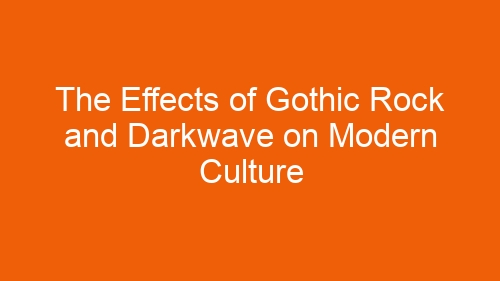-
Table of Contents
Influence of Gothic Rock and Darkwave Fashion Trends
Gothic rock and darkwave music have had a significant impact on modern culture, influencing not only the music industry but also fashion trends. The dark and moody aesthetic of these genres has inspired a unique style that has become popular among many individuals. From the music videos of bands like The Cure and Sisters of Mercy to the runway shows of high-end fashion designers, the influence of gothic rock and darkwave can be seen in various aspects of contemporary fashion.
One of the most notable effects of gothic rock and darkwave on fashion is the emergence of a distinct subculture known as goth. Characterized by its dark and edgy style, goth fashion often incorporates elements such as black clothing, leather, lace, and studs. This subculture has its roots in the music scene of the 1980s, with bands like Bauhaus and Siouxsie and the Banshees playing a key role in shaping its aesthetic. Today, goth fashion continues to evolve, with modern interpretations incorporating elements of streetwear, punk, and high fashion.
In addition to goth fashion, the influence of gothic rock and darkwave can also be seen in mainstream fashion trends. Designers such as Alexander McQueen, Rick Owens, and Gareth Pugh have all drawn inspiration from the dark and brooding aesthetic of these genres, incorporating elements such as black leather, lace, and dramatic silhouettes into their collections. The result is a style that is both edgy and sophisticated, appealing to a wide range of fashion-forward individuals.
The impact of gothic rock and darkwave on fashion extends beyond the runway, with many high-street retailers and fast-fashion brands also embracing the dark and moody aesthetic. Stores like Hot Topic and Killstar cater to a younger demographic looking to express their individuality through clothing that reflects their love of gothic music and culture. From graphic tees featuring band logos to statement accessories like chokers and platform boots, these brands offer a wide range of options for those looking to incorporate gothic elements into their wardrobe.
The influence of gothic rock and darkwave on fashion is not limited to clothing, however. Hairstyles, makeup, and accessories also play a key role in creating a gothic look. Dark, dramatic makeup featuring bold lips, smoky eyes, and pale skin is a hallmark of goth fashion, while hairstyles such as long, flowing locks or short, choppy cuts add to the overall aesthetic. Accessories like crucifixes, pentagrams, and spiked jewelry are also popular among those who embrace the gothic style.
Overall, the effects of gothic rock and darkwave on modern culture are undeniable, with their influence extending far beyond the realm of music. From the emergence of the goth subculture to the incorporation of dark and moody elements into mainstream fashion trends, these genres have left a lasting impact on the way we dress and express ourselves. Whether you’re a die-hard fan of gothic music or simply appreciate the edgy aesthetic it inspires, there’s no denying the power of gothic rock and darkwave in shaping the world of fashion.
Impact of Gothic Rock and Darkwave Music on Contemporary Artists
Gothic rock and darkwave music have had a profound impact on modern culture, influencing a wide range of contemporary artists across various creative fields. These genres, characterized by their dark and moody soundscapes, introspective lyrics, and haunting melodies, have inspired a new wave of creativity and innovation in the arts.
One of the most notable effects of gothic rock and darkwave music on modern culture is its influence on visual arts. Many contemporary artists draw inspiration from the dark and brooding aesthetic of these genres, incorporating elements of gothic and darkwave imagery into their work. From paintings and sculptures to photography and graphic design, the influence of gothic rock and darkwave can be seen in a wide range of artistic expressions.
In addition to visual arts, gothic rock and darkwave music have also had a significant impact on literature and poetry. Many writers and poets have been inspired by the melancholic themes and introspective lyrics of these genres, incorporating elements of gothic and darkwave music into their own creative writing. The result is a new wave of literature that explores themes of darkness, despair, and existential angst, reflecting the mood and tone of gothic rock and darkwave music.
Furthermore, the influence of gothic rock and darkwave music can also be seen in fashion and design. Many contemporary fashion designers draw inspiration from the dark and edgy aesthetic of these genres, creating clothing and accessories that reflect the moody and brooding vibe of gothic rock and darkwave music. From black leather jackets and lace-up boots to dramatic makeup and accessories, the influence of these genres can be seen in the fashion choices of many individuals today.
Moreover, gothic rock and darkwave music have also had a significant impact on film and television. Many filmmakers and directors have drawn inspiration from the dark and atmospheric soundscapes of these genres, incorporating elements of gothic and darkwave music into their soundtracks to create a mood of tension and suspense. The result is a new wave of films and television shows that explore themes of darkness, horror, and the supernatural, reflecting the influence of gothic rock and darkwave music on contemporary storytelling.
In conclusion, the effects of gothic rock and darkwave music on modern culture are far-reaching and profound. From visual arts and literature to fashion and design, these genres have inspired a new wave of creativity and innovation in the arts, influencing a wide range of contemporary artists across various creative fields. The dark and moody soundscapes, introspective lyrics, and haunting melodies of gothic rock and darkwave music continue to resonate with audiences today, shaping the cultural landscape in new and exciting ways.
Evolution of Gothic Rock and Darkwave Subculture in the Digital Age
Gothic rock and darkwave music have had a significant impact on modern culture, influencing everything from fashion to literature to film. These genres emerged in the late 1970s and early 1980s as a response to the punk and new wave movements, with bands like Bauhaus, Siouxsie and the Banshees, and The Cure leading the way. The dark, brooding sound of gothic rock and darkwave resonated with a generation of disaffected youth, who found solace in its melancholic lyrics and haunting melodies.
As the subculture surrounding gothic rock and darkwave grew, so too did its influence on other aspects of popular culture. Fashion designers drew inspiration from the dark, romantic aesthetic of gothic rock, incorporating elements like black lace, leather, and corsets into their collections. Films like “The Crow” and “Interview with the Vampire” embraced the gothic sensibility, with their moody visuals and themes of love and death. Even literature was not immune to the influence of gothic rock and darkwave, with authors like Anne Rice and Neil Gaiman drawing on the genre’s themes of darkness and despair in their work.
In the digital age, the subculture surrounding gothic rock and darkwave has only continued to evolve and expand. Social media platforms like Instagram and Tumblr have allowed fans to connect with one another and share their love of the music and aesthetic. Online communities like Reddit and Discord have provided a space for fans to discuss their favorite bands, share new music, and organize events like concerts and festivals.
The rise of streaming services like Spotify and Apple Music has also had a profound impact on the gothic rock and darkwave subculture. These platforms have made it easier than ever for fans to discover new music and support their favorite artists. Bands that may have struggled to find an audience in the past now have the opportunity to reach a global fanbase, thanks to the power of the internet.
Despite these advancements, the essence of gothic rock and darkwave remains the same. The music is still characterized by its dark, atmospheric sound, haunting vocals, and introspective lyrics. Bands like Chelsea Wolfe, Drab Majesty, and Cold Cave continue to push the boundaries of the genre, blending elements of electronic music, post-punk, and shoegaze to create a sound that is uniquely their own.
In conclusion, the evolution of gothic rock and darkwave in the digital age has had a profound impact on modern culture. From fashion to film to literature, the influence of these genres can be seen everywhere. As technology continues to advance, it will be interesting to see how the subculture surrounding gothic rock and darkwave continues to grow and evolve. One thing is certain: the dark, brooding sound of these genres will continue to captivate audiences for years to come.




















